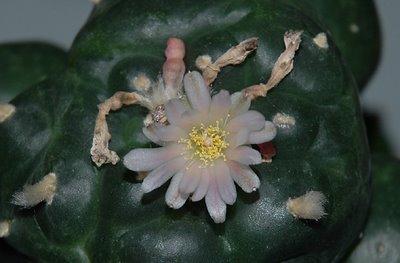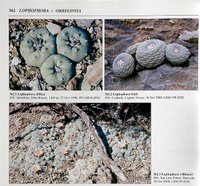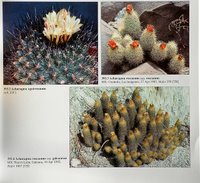Having passed the autumnal equinox I hadn’t expected any more flowers from my lophs – nevertheless two of them decided to bloom this week, one for the first time.

Lophophora williamsii (SB 854; Starr Co, Tx) flower
My grafted Lophophora williamsii (SB 854; Starr Co, Tx) has been flowering abundantly all summer. Several fruits have already ripened and more are budding; still the plant took the opportunity to squeeze in yet another flower before going dormant. The flowers of this plant are quite large, approximately 2.75cm (~1.1'') in diameter.

Lophophora williamsii var. caespitosa flower
The Lophophora williamsii var. caespitosa graft has been growing profusely but never felt like flowering before now. The flowers are small, less than 2cm (~0.8'') in diameter, compared to those of L. williamsii (SB 854; Starr Co, Tx), and the midstripes are a slightly darker shade of pink.

Lophophora williamsii var. caespitosa
The scion used for this graft was taken from the plant shown in the blog profile. Unfortunately this plant later caught rot and died.
Saturday, September 30, 2006
Lophophora williamsii – autumn flowers
Sunday, September 17, 2006
The New Cactus Lexicon: A Review
![]() The New Cactus Lexicon
The New Cactus Lexicon
David Hunt, Nigel Taylor, Graham Charles
dh books, 2006
ISBN 0 9538134 4 4
After a lengthy gestation period, the New Cactus Lexicon was published this summer. For ease of handling it’s divided into two volumes – the text volume is a concise alphabetical catalogue of cactus genera, species and subspecies accepted or proposed in the current standard literature on cacti, while the atlas volume contains more than 2500 illustrations covering nearly all of the species and subspecies recognized in the text, sometimes with two or more images.
Atlas volume
With its 526 pages of illustrations this volume is a stunning visual masterpiece, and the most comprehensive pictorial record of cacti ever published (the slightly blurred quality of the examples is entirely due to my reproduction).
 The aim of the atlas volume is to illustrate all of the recognized species, with an emphasis on using photographs of plants in habitat at a specified locality or in cultivation from a known source, whenever possible.
The aim of the atlas volume is to illustrate all of the recognized species, with an emphasis on using photographs of plants in habitat at a specified locality or in cultivation from a known source, whenever possible.
The entries in the atlas are not grouped alphabetically but rather ‘like with like’, making it easier for the user to compare related species or identify unnamed plants.
Text volume
The text volume comprises 373 pages and is a no-frills dictionary of the currently recognized genera, species and subspecies of cacti. It does not include any chapters of general information about the family, its history, morphology, ethnobotany, cultivation and so on – so don’t expect an encyclopedic work like Anderson’s The Cactus Family or Benson’s Cacti of the United States and Canada.
David Hunt is a known lumper and some of the main genera changes (Parodia now includes the former Notocactus, Echinopsis including Lobivia and Trichocereus etc.) have already been the cause of much debate (maybe that’s the reason for Hunt quoting Bill Bryson for having said “Taxonomy is sometimes described as a science and sometimes as an art, but really it’s a battleground” ;-).
 Still, there has been room for some splitting , e.g. the division of Opuntia has added 12 genera, Lophophora fricii is now recognized as a valid species, Acharagma is not submerged in Escobaria, etc.
Still, there has been room for some splitting , e.g. the division of Opuntia has added 12 genera, Lophophora fricii is now recognized as a valid species, Acharagma is not submerged in Escobaria, etc.
Whether you agree with Hunt’s classification or not, the New Cactus Lexicon is an excellent reference and certainly will become the reference book for years to come. As already mentioned the atlas volume is in a league of its own with excellent illustrations of the majority of the recognized cacti species and subspecies.
You can find more information on the New Cactus Lexicon in this post.
The book can be acquired directly from dh books or from specialized bookstores like Rainbow Gardens Bookshop or Keith’s Plant Books.
All Time Most Popular Posts
-
Lophophora williamsii (peyote) populations have diminished in large areas of South Texas where peyoteros harvest the cactus for ceremonial ...
-
On various occasions I've been asked what growing media I'm using for my cactus plants. I don't have a set soil mix recipe as su...
-
Below is a list of retailers/nurseries selling cactus seed and plants. I've only listed vendors I've done business with. If you ar...
-
Most cacti are easily grown from seed - and with a little patience and care they can be grown into beautiful plants. Lophophora williamsi...
-
In last month’s post on the troubled Texan peyoteros I referred to Anderson’s article on the peyote situation in Texas. Given the importanc...
-
Yet another slightly off topic and probably not entirely politically correct post, but I couldn’t help noticing the similarity of my monstr...
-
Flowering stand of San Pedro cacti (Trichocereus pachanoi) To me the main draw of the San Pedro cactus ( Trichocereus pachanoi (syn. Ech...
-
In the June 2008 issue of the Cactus & Co magazine Jaroslav Šnicer, Jaroslav Bohata, and Vojtěch Myšák described a new Lophophora spec...
-
There seems to be an increased focus on the alarming Texas peyote situation. A couple of weeks ago the Houston Press published a mournful, i...
-
I spent two weeks working in Delhi, India during January. I had one weekend off and had planned to spend it in Delhi at my own leisure, but ...


















